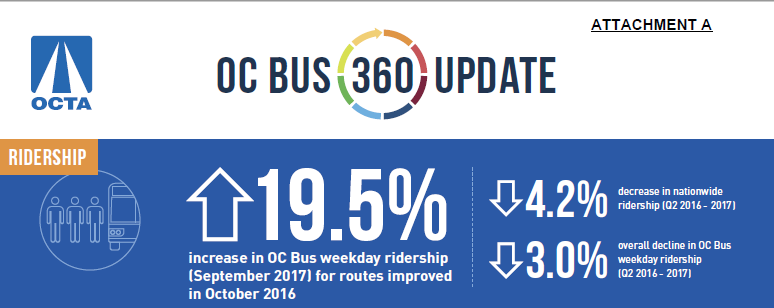The Orange County Transportation Authority (OCTA) launched a multileveled overhaul of its bus system--OC Bus 360°--last year, and the results are finally showing some positive signs. While bus ridership declined by three percent countywide, bus ridership on routes in core areas of the county where service was improved was up 19.6 percent as of September 2017. Some of the improved routes include the Bravo! and X lines, which offer increased bus frequency and fewer stops.
At a time when ridership has been declining in many cities nationwide, Orange County's ridership is following a different trend. Los Angeles Metro experienced almost a seven percent ridership decline in the last year, while ridership in Long Beach declined six percent and in Santa Clara 6.5 percent. This is a huge reversal from when Orange County was a leader in ridership declines. Between 2004 and 2014, boardings in Orange County had declined by thirty percent.
At last week’s OCTA board of directors meeting, staff described how improved bus routes, a new student college bus pass, and technology improvements have helped to add new riders.
As part of the overhaul, OCTA cut service in southern parts of the county, where ridership was lower, and added service to north county routes where ridership was highest. This has left a dearth of service in areas that were cut, but OCTA is planning to pilot on-demand transit service next summer in Huntington Beach, Laguna Niguel, and Mission Viejo.
“Operating traditional bus service in every corner of the county is no longer an efficient or cost-effective way to operate a transit system,” said OCTA CEO Darrell Johnson in a statement. “The OC Bus 360° efforts clearly indicate that successful public transportation in the future will result from targeted solutions for the individual needs of the 3.1 million people in Orange County.”
Ridership increases came also from a popular pass now offered to Santa Ana College students. In its first eight weeks, more than 3,000 students signed up for the student pass, adding an additional 171,555 boardings, according to the staff’s report. Introduced in August, OCTA's three-year pilot program allows all students with a valid Santa Ana College student I.D. to ride the bus for free for the first year. It will cost second and third-year students a whopping $6.75 for full-time and $5.75 for part-time students per semester for the unlimited pass.
The OC Bus mobile-ticketing app has also seen wider usage since it launched last year. The app, which allows riders to buy passes on a smartphone, has had 67,000 downloads, with an average of 300 new app users per week. Mobile purchases now account for more than seven percent of total fare revenue, double the industry average.
There are more changes to come next year. At last month's board meeting, the board moved forward with additional changes to the bus service, which will go into effect on February 11, 2018. For a list of all the changes, go to OCTA's website.






